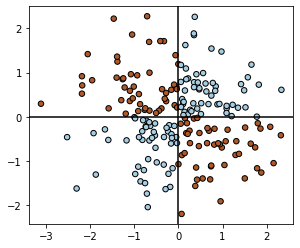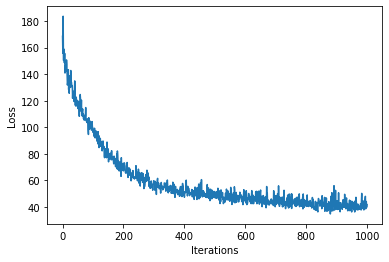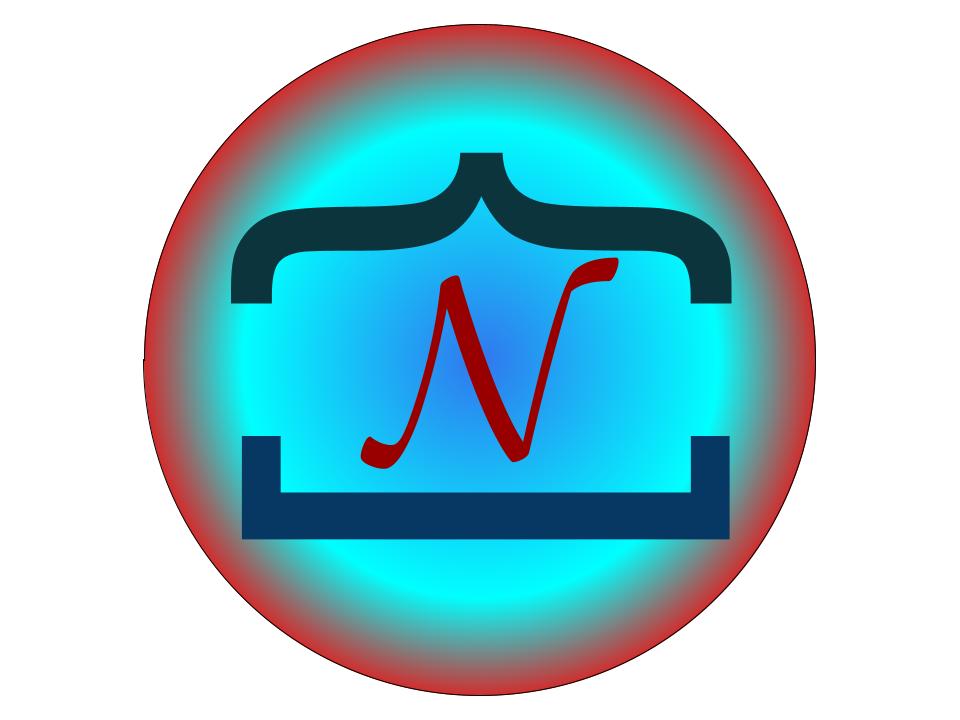GP Classification#
We will now briefly discuss GP classification. First, we create a simple XOR dataset (inspired by the code and plots from scikit-learn example for GP classification).
import torch
import matplotlib.pyplot as plt
from mpl_toolkits.axes_grid1 import make_axes_locatable
import pyro.contrib.gp as gp
import pyro
X = torch.randn(200, 2)
y = torch.logical_xor(X[:, 0] > 0, X[:, 1] > 0).double()
plt.scatter(X[:, 0], X[:, 1], s=30, c=y, cmap=plt.cm.Paired, edgecolors=(0, 0, 0))
plt.gca().set_aspect("equal")
plt.axhline(0, color="k")
plt.axvline(0, color="k")
<matplotlib.lines.Line2D at 0x103a16160>

For binary classification, we build on our model from GP regression and use: $\(f \sim \mathcal{GP}\left(0, \mathbf{K}_f(x, x')\right)\)$
and use a sigmoid likelihood
or $\(y \sim \mathrm{Bernoulli(Sigmoid(f))}\)$
Note, here we wrote \(\mathrm{Sigmoid}\) instead of \(\sigma\) to prevent confusion.
Given the non-Gaussian likelihood, we use VariationalGP as our GP method and Binary as likelihood.
For the interested reader, in implementation, we may sometimes see the above equations written as: y_dist = dist.Bernoulli(logits=f) where we can directly specify the logits, instead of first applying sigmoid and then calling y_dist = dist.Bernoulli(probs=f)
kernel = gp.kernels.RBF(input_dim=2)
pyro.clear_param_store()
likelihood = gp.likelihoods.Binary()
model = gp.models.VariationalGP(
X, y, kernel, likelihood=likelihood, whiten=True, jitter=1e-03
)
num_steps = 1000
loss = gp.util.train(model, num_steps=num_steps)
plt.plot(loss)
plt.xlabel("Iterations")
plt.ylabel("Loss")
Text(0, 0.5, 'Loss')

mean, var = model(X)
y_hat = model.likelihood(mean, var)
print(f"Accuracy: {(y_hat==y).sum()*100/(len(y)) :0.2f}%")
Accuracy: 95.50%
We see that our model did a reasonable job and got a good accuracy on the train data. Let us now visualize the predictions over a 2d grid.
xs = torch.linspace(-2, 2, steps=100)
ys = torch.linspace(-2, 2, steps=100)
# In newer version we should uncomment the following line
# xx, yy = torch.meshgrid(xs, ys, indexing="xy")
xx, yy = torch.meshgrid(xs, ys)
xx = xx.t()
yy = yy.t()
/Users/nipun/miniforge3/lib/python3.9/site-packages/torch/functional.py:445: UserWarning: torch.meshgrid: in an upcoming release, it will be required to pass the indexing argument. (Triggered internally at /Users/runner/miniforge3/conda-bld/pytorch-recipe_1643987874214/work/aten/src/ATen/native/TensorShape.cpp:2157.)
return _VF.meshgrid(tensors, **kwargs) # type: ignore[attr-defined]
with torch.no_grad():
mean, var = model(torch.vstack((xx.ravel(), yy.ravel())).t())
Z = model.likelihood(mean, var).reshape(xx.shape)
def plot_pred_2d(arr, xx, yy, contour=False, ax=None, title=None):
if ax is None:
fig, ax = plt.subplots()
image = ax.imshow(
arr,
interpolation="nearest",
extent=(xx.min(), xx.max(), yy.min(), yy.max()),
aspect="equal",
origin="lower",
cmap=plt.cm.PuOr_r,
)
if contour:
contours = ax.contour(
xx,
yy,
torch.sigmoid(mean).reshape(xx.shape),
levels=[0.5],
linewidths=2,
colors=["k"],
)
divider = make_axes_locatable(ax)
cax = divider.append_axes("right", size="5%", pad=0.1)
ax.get_figure().colorbar(image, cax=cax)
if title:
ax.set_title(title)
fig, ax = plt.subplots(ncols=3, figsize=(12, 4))
plot_pred_2d(mean.reshape(xx.shape), xx, yy, ax=ax[0], title="f")
plot_pred_2d(
torch.sigmoid(mean).reshape(xx.shape),
xx,
yy,
ax=ax[1],
title="p(y=1|f) = Sigmoid(f)",
contour=True,
)
plot_pred_2d(Z, xx, yy, ax=ax[2], title="Predictions (y) ~ Bernoulli(p(y=1|f))")
fig.tight_layout()


